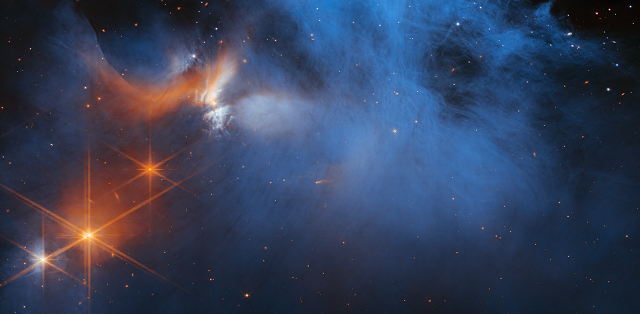Mar. 17, 2023 Research Highlight Physics / Astronomy
Space telescope probes chemistry around a newborn star
The origins of organic molecules that may create suitable ingredients for the birth of life are beginning to be revealed by the James Webb Space Telescope
The James Webb Space Telescope (JWST) is set to transform astronomers’ understanding of the chemistry of newly formed stars, with an analysis by RIKEN researchers of early results showing that it can detect complex organic molecules in the clouds of gas and ice surrounding a newborn star1.
A protostar is a newly formed star that is still feeding on an envelope of infalling matter that spawned it. These envelopes host chemical reactions that transform simple chemical building blocks into more complex organic molecules, which may be the precursors of the molecules necessary for life to arise.
Researchers suspect that these complex organic molecules are formed in chemical reactions that occur on the surfaces of ice grains. As the star warms the molecules, they leave the ice and mingle with the gas around them.
“We want to obtain definitive proof of such formation pathways,” says Yao-Lun Yang of the RIKEN Star and Planet Formation Laboratory. “And JWST provides the best opportunity to do so.”
Launched in December 2021, JWST sits about 1.5 million kilometers from Earth. Yang, along with RIKEN colleagues Yuki Okoda and Nami Sakai and members of the CORINOS team, used data from the telescope’s Mid-Infrared Instrument (MIRI), acquired in July 2022, to study a very young protostar.

Figure 1: A false-color image obtained by the James Webb Space Telescope (JWST) of a protostar (orange region in upper left; a different protostar from the one in the present study). JWST uses infrared instruments to study how protostars shape the chemistry of icy clouds (blue wisps). © 2023 NASA, ESA, CSA High-resolution versions of this image can be viewed in the article "Webb’s View of the Molecular Cloud Chameleon I".
When molecules absorb certain frequencies of infrared light, they stretch and bend in different ways depending on their structures. Since each kind of molecule absorbs infrared light at a characteristic set of frequencies, the infrared spectrum detected by MIRI can identify which molecules are present around the protostar.
Previous surveys of the protostar had identified complex organic molecules in the gas phase, MIRI offers a much more detailed picture since it can detect organic molecules in ice, where they are thought to form. The results confirm the presence of water ice, carbon dioxide and silicates, found in dust, along with molecules such as ammonia, methane, methanol, formaldehyde, and formic acid. There are also hints of ethanol and acetaldehyde.
Protostars often produce outflows and jets, and this protostar is no exception. MIRI produced images that reveal the structure of one of the star’s outflows, showing at least four shell-like structures. The outflow contains a jumble of elements including hydrogen, iron, nickel, neon, argon and sulfur. Some are concentrated in a relatively hot jet moving at about 200 kilometers per second. These ejections are being observed when they are perhaps only 170 years old—a mere blink of the eye in terms of star development.
All these results bode well for the future. “We will begin to understand how organic chemistry emerges,” says Yang. “And we will also uncover the lasting impacts on planetary systems similar to our Solar System.”

Yao-Lun Yang has used the JWST space telescope to study complex organic molecules in the clouds of gas and ice surrounding a newborn star. © 2023 RIKEN
Related contents
- Complex flows of cold gas are shedding light on stellar nurseries
- Nascent gas giant planets may be lurking in dusty disk
- Planet formation may start earlier than previously thought
Rate this article
Reference
- 1. Yang, Y.-L., Green, J. D., Pontoppidan, K. M., Bergner, J. B., Cleeves, L. I., Evans, N. J., Garrod, R. T., Jin, M., Kim, C. H., Kim, J. et al. CORINOS. I. JWST/MIRI spectroscopy and imaging of a class 0 protostar IRAS 15398–3359. The Astrophysical Journal Letters 941, L13 (2022). doi: 10.3847/2041-8213/aca289
